Darkest Days by Dates Down Under: Part 2
The Great Divide — 1981 Springbok Rugby Tour, New Zealand
This "Darkest Days by Dates Down Under" series explores how New Zealand’s crises are thematically encoded with historical riffs to signal authorship, cooperation, scapegoats and caution — while telegraphing hidden objectives.Introduction
The 1981 Springbok Tour divided New Zealand into two broad camps between those opposed to the South African rugby team playing matches, and those who wanted the tour to proceed. The civil unrest sparked by the tour was entirely predictable.
Indeed, Norman Kirk, in his role as Prime Minister, had cancelled a proposed tour in 1973 on the basis of a report that concluded: “it is the considered police view that the tour would engender the greatest eruption of violence this country has ever known.”
Yet, the reasons that the 1981 Springbok Tour went ahead remain poorly understood. The Muldoon Government had established a ‘policy’ that claimed politics was not to be mixed with sports, which was like denying heat has anything to do with steam.
In this dispatch former Māori Television news and current affairs editor Steve Snoopman, reveals the uncanny repetition of key Tour dates associated with the death of the black rights activist, Steve Biko, at the brutish hands of Afrikaner police.
As a modus operandi, such historical riffing signals authorship, cooperation, caution and to telegraph objectives. The signals suggest players are communicating their cooperation to take a plot ‘live’, convey hidden objectives and to broadcast psychotic humour, thereby posting themselves like hostages — as applied game theory predicts.
In this “Darkest Days by Dates Down Under” series, Snoopman surveys the curious coincidences of calamities, catastrophes, or crises that jolted the nation while power, wealth and control were accumulated. In this disturbing multi-decade sketch, Snoopman traces the creepy trail of spooky minds, who he believes plot machinations with an eye on the past and a dark vision of the future. The circumstantial evidence reveals an awful picture of each new administration becoming embroiled in a cover-up of a staged event made to appear as an accident, a natural disaster, or a crisis caused by an unhinged man, or an ‘unsolved’ crime. This deep state network will continue plotting events with this historical riffing modus operandi until it becomes too risky to continue to do so, or because they have been caught and jailed, he opines.
The tumultuous episode of the 1981 Springbok Tour, was intended to deliver the National Government back into power, since the shocking news coverage of escalating clashes between police and protestors would provide a distraction from the economic issues that snowballed on Muldoon’s watch. Moreover, by funding security for the Springbok Tour, Muldoon’s Cabinet made the nation’s defacto religion into a political football to rescue Air New Zealand, the Civil Aviation Authority and the Beehive from deeper scrutiny over the 1979 ‘Erebus Disaster’, Snoopman believes.
Springbok Tour, 22 July to September 12 1981 — Death Toll: 0
On November 3 1979, Halt All Racist Tours (HART) launched a 500-day campaign to stop a Springbok tour earmarked to occur in New Zealand in 1981. I contend that elements of a transnational deep state network, with an eye for interferring in New Zealand, worked in cahoots with a criminal network operating in N.Z. to stage the ’81 Springbok Tour as a contingency to deal with the aftermath of the planned Erebus Crash. A Labour Government would threaten the ‘necessary’ cover-up, and therefore delivering a compromised National back into power in later 1981 would be optimal.
What better way to distract, divide and defeat a nation than to stage a tour of a rugby team to the rugby-mad ‘Little Britain of the South Pacific’— that is also inhabited by a committed anti-apartheid movement — while sanctimoniously saying politics shouldn’t interfere with sports? Conspicuously, Immigration Minister Anthony ‘Aussie’ Malcolm would not decline the Springboks entry visas, despite the Human Rights Commission stating that by facilitating the Tour, the Government would be breaching the Glen Eagles’ Agreement, which required signatures to the treaty to not materially support sporting contact with South Africa’s sport teams. At the time of his death on 11 September 2024, ‘Aussie’ Malcolm was under police investigation for historical claims that he had been interferring with children. But, it seems politics interferred with the police investigations, as it had with so many others for decades.
Ergo, over multiple administrations politics interferred with the protection of innocence, while the public was distracted with the nation’s defacto religion: rugby.
By early spring of 1980, Muldoon’s Government faced a crisis of legitimacy over the epic Erebus cover-up — amid a Royal Commission inquiry, and back-lash about his dominance over a stagnant economy shaken by two Oil Price Shocks. With magical synchronicity, the New Zealand Rugby Union announced the 1981 Springbok Tour on September 12 1980, which coincided with the third anniversary of the death of black rights activist, Steve Biko, at the hands of the Afrikaner Broederbond’s fascist security henchmen. While the Springboks played the All Blacks at Eden Park, the ‘finale’ clash occurred on the streets outside — on September 12th. Muldoon was re-elected in 1981.
Ironically, the Afrikaner Brotherhood had modelled their secret society on the Freemasons and the Sons of England, as Ivor Wilkins and Hans Strydom found while investigating their book, The Super-Afrikaners: Inside the Afrikaner Broederbond.
Merata Mita's 1983 documentary Patu! suggested the provocative timing of the New Zealand Rugby Union's announcement of the Springbok Tour, that took place on September 12th 1980. Mita noted the news came on the third anniversary of the death of black rights activist, Steve Biko. In the documentary, A Country at War, Bill Ralston described a proxy war for domestic race relations; a view also expressed by Ian Fraser in Fortress New Zealand, part 1 of Revolution that aired on TVNZ in 1996. Amid the societal division opened by the Tour, Muldoon returned to power as intended. The Springbok Tour was designed to distract, divide and divert attention, not merely from the economic discontent, as Ian Fraser espoused. I think the Springbok Tour was also timed as a damage control mechanism, since Muldoon's Government had hoped the report by the Inspector of Air Accidents, Ron Chippendale, would be enough to quiet the New Zealand Pilots Association, the news media, and the public. Muldoon was ropable when High Court Judge, Peter Mahon, not only accused Air New Zealand of a conspiracy to cover-up their culpability in the crash. But also, Mahon said he couldn't accept the misleading flight coordinates transmitted to McMurdo Sound by the airline's Navigation Section hours before take-off — were yet another mistake.Opposition to South African sport teams had become a frontline for protests since the 1960s, as a worldwide movement developed to confront the country’s apartheid regime, that discriminated againt the native and Indian populations. The apartheid regime was run by the Afrikaner Broederbond, which was established in 1918, toward the end of World War I, after the Afrikans took stock of how they lost the Boer War 1899 to 1902. The Afrikans forged a brotherhood to re-establish dominance.
On 13 July 1981, senior NZSIS officers concluded that the key leaders of the anti-apartheid movement were “extremists”. There were 13 provincial matches scheduled. The first game occurred on the 22 July in Gisbourne, where 13 protestors were arrested. The second match was cancelled due to anti-Apartheid protestors occupying the pitch. After the finale third test at Eden Park, the Spingboks departed on 13 September for the U.S. The Deep State dropped their ‘Thirteens’ bag of illuminati.
The New Zealand Security Intelligence Service officers appeared to be riffing off the clandestine history of the Central Intelligence Agency (CIA), in timing their meeting.
On 13 July 1951, Prime Minister Sydney Holland confronted locked out dockers and coal miners intent on what he called “industrial anarchy”, called a snap election. Ostensibly, Holland wished to test the feeling of the country on his handling of the watersiders’ strike, that made ports idle. Naturally, he didn’t publicly say the CIA’s proprietry airliner, euphemistically named Civilian Air Transport (CAT), had by that time been enlisted to fly cargo by night to maintain commerce and break the strike.
On 25 July 1981, a few hundred anti-apartheid protestors occupied the pitch at Rugby Park in Hamilton. The game was called off. The second-in-command of the Red Squad, Ross Meurant was told to report to Prime Minister Muldoon what had occurred. Meurant wrote that Muldoon authorized the “Red Squad Solution” after hearing the police commander say that with the “Red Squad let out of the cage, [they] would win every encounter with the protesters”. A blood-bath ensued, as expected.
Ergo, a modus operandi of staged operations is ensuring a strategic withdrawal of security, to let the mayhem happen and then ‘regretfully’ invoke emergency powers.
Naturally, Meurant didn’t see any irony in the fact that when he spoke by phone to the Minister in charge of National Security and Intelligence, the Red Squad Commander was having dinner in a military mess hall in Taranaki. Nor did Meurant see any irony in recalling the 1951 Waterside Strike as a comparison of the civil unrest.
It turns out, Muldoon’s authorization of the “Red Squad Solution” meant that in effect, emergency powers to put down civil disobedience were invoked on the historical date that emergency regulations to overcome the 1951 Watersiders Strike were revoked, on 25 July 1952. It would appear NZ’s deep state were consulting A.W. Reed’s 1971 edition of It Happened Today in New Zealand to riff off history. During the 1951 Waterfront Dispute, the CIA flew 1300 flights across the Cook Strait, under the auspices of Operation Railhead, to keep commerce bouyant, and break the strike.
Is the CIA really the Central Interference Agency? James Sanders stated in his book Apartheid’s Friends: The Rise and Fall of South Africa’s Secret Service (SASS), Nelson Mandela was imprisoned for 27 years, from 1963 to 1990, after the CIA assisted in his arrest by passing on his travel plans to the South African Security Service.
Ergo, Prime Minister Norman Kirk’s warning eight years earlier that a Springbok Tour would result in the ‘greatest eruption of violence this country has ever known’ — came true. Muldoon refused to block the N.Z. Rugby Union’s plan to host the South African Springboks, despite the Human Rights Commission finding that hosting the South African Rugby team would be a breach of the Glen Eagles’ Agreement.
The Muldoon Government adopted a ‘policy’ that politics should not be mixed with sport, which worked as a group processing mantra to brainwash the population. At the time, rugby was a defacto-state religion. Much of the population was addicted to the ritual battles on the pitch, without any awareness that the British Empire spread rugby and cricket as a form of unifying power. As a form of social cohesion between the classes, such sports were intended to work like glue, while distracting the masses from important political matters to lessen the opposition to imperial domination.
The Red Escort Group, dubbed the ‘Red Squad’, prepared for the tour at the Papakura SAS military training facility, which is where the first Police Anti-Terrorism Squads (ATS) trained when they were established in 1977. The ‘finale’ clash between protesters and police on September 12th 1981, confirms a deliberately divisive group processing of the population to jolt the political center of gravity toward the right.
The timing of the final test on September 12 1981 between the Springboks and the All Blacks was provocative — as the NZ Herald reported in 2021— since it was the fourth anniversary of Steve Biko being fatally beaten by police in a Port Elizabeth cell.
Even the Stop the Tour Action Committee recognized the inherent provocation, and they produced this poster titled “Day of Rage September 12” to rally the foot soldiers.
Ergo, the brotherhoods of New Zealand and South Africa were rubbing the NZ’s public’s nose in the political equivalent of cat-shit, since the ‘finale’ clash occurred on the streets outside Eden Park — on September 12th, or precisely one year after the NZ Rugby Union’s announcement of the Tour. That announcement was made on the third anniversary of Biko’s death at the hand’s of the Afikaner Broederbond. Therefore, the NZ Rugby Union communicated they were ‘all in’ with Muldoon’s narcissistic ‘need’ to pick a fight in order to maintain power, cover-up the Erebus Crash, and deflect attention from the economic woes, which were the pretext for the coming ‘reforms’.
The possibility of a Labour-led Government in 1981 was successfully de-risked, and subsequently the police investigation into the Erebus Crash —that had been triggered by Peter Mahon’s scathing Royal Commission report — was subsequently shutdown.
At the time of the Erebus Crash, when an Air New Zealand DC10 slammed into an Antarctic mountain on November 28 1979 and killed all 257 aboard, Robert Muldoon was finance minister, and was the sole shareholder of the state-owned airline.
The release of the Royal Commission’s scathing report, which alleged a conspiracy to cover-up the airline’s culpability for crash, placed enormous pressure on Muldoon. Peter Mahon’s report pointed to a deliberate operation to crash the DC10 into the icy mountain. He did not the accept that the pile up “administrative blunders” were all a horrific series of errors amid poor governance at the airline and with the regulator.
In the aftermath of all hell breaking loose, the chairman of the Auckland Rugby Union Ron Don proclaimed “we won” in 1981. On the other hand, John Minto, the leader of the Halt All Racist Tours (HART), said social change doesn’t happen without struggle.
40 years after the Springbok Tour, Minto told the Whanganui Chronicle, New Zealand in 1981 was the most divided it had been since the Land Wars of the 19th century.
The timing of the finale test match between the All Blacks and the Spring Boks on the fourth anniversary of Steve Biko’s murder was potent, provocative and politicized.
The intention was to construct a climatic clash between protestors and police, and provide the propagandist imagery that only with a Muldoon Government could law and order prevail. With this cronyism apparent between the Old Boys’ Network, rugby was weaponized as a mechanism to short-circuit the backlash over the Erebus Crash, to distract the public from the economic turmoil, and to divide the land over the Tour.
Violence was metted out by police, protesters and the sports fan public over the Tour.
Ergo, the left-right political paradigm worked to divide, distract and defeat the nation from comprehending why they had really been ‘seeing red’, at that moment in history.
Ergo, my key finding is that the Springbok Tour was thematically encoded with apartheid and class conflict metaphors codified into the historical riffs to signal cooperation, caution and a crisis cover-up — while telegraphing a spooky objective.
A deep state network operating in and outside of the government, had free rein to inflict police state violence with impunity, to assist propelling the incumbent PM back into power. By manufacturing a crisis to deflect attention from the Erebus cover-up, amid economic hardships, and poor race relations, New Zealand’s establishment had averted a larger crisis of legitimacy for the Muldoon Government, Air New Zealand and the Civil Aviation Authority. They had conjured a controversial news narrative that would be like lacy lingerie: the gift that would keep on giving, while any chance of transparency over the Erebus Crash would be consigned to a Police filing cabinet.
* Each of the examined crises are entwined either by dates, institutions and players, or by references to prior events, either domestic or international, that indicate NZ’s national security state is more interested in accumulating power than fully disclosing the truth of such events. Patterns emerge such as training exercises ‘going live’, institutional transitions impairing emergency responders, and an apparent ‘too stupid to be stupid’ modus operandi that is repeatedly passed off as bureaucratic blunders, corporate clownery or government grandeur. Yet, hidden hands are detectable. The broad range of crises points to a well-resourced criminal network that functions with hierarchical structures and with deep penetration in New Zealand institutions, to command an operational level army of ‘soldiers’ to implement the complex plots.
SEE: Darkest Days by Dates Down Under series introduction
Moving a Mountain — The Crash of Flight TE901: November 28 1979
Darkest Days by Dates Down Under: Part 1 [The Snoopman Files]
Transport Themed Terrorism — Wellington Trades Hall Bombing, March 27 1984
Darkest Days by Dates Down Under: Part 3
See also: “Terror Archipelago Down Under? Pt 1 Industrial Sabotage, Ritual Terrorism, and Police State Formation in New Zealand” on Snoopman News
Back when Steve Snoopman was ‘Snoopboy’, he delivered the Auckland Star during the dark days of the Reagan White House. He forged his superpower to ‘Thunk Evil Without Being Evil’ while writing a thesis on the Global Financial Crisis. Upon quipping that Batman had failed to bust any Gotham banker balls — since his ass is owned by DC Comics — he consequently realised New Zealand needed a Snoopman.
Editor’s Note: If we have made any errors, please contact Steve ‘Snoopman’ Edwards with your counter-evidence. e: steveedwards108[at]protonmail.com
Steve Snoopman also posts on Snoopman News [at] https://snoopman.net.nz/


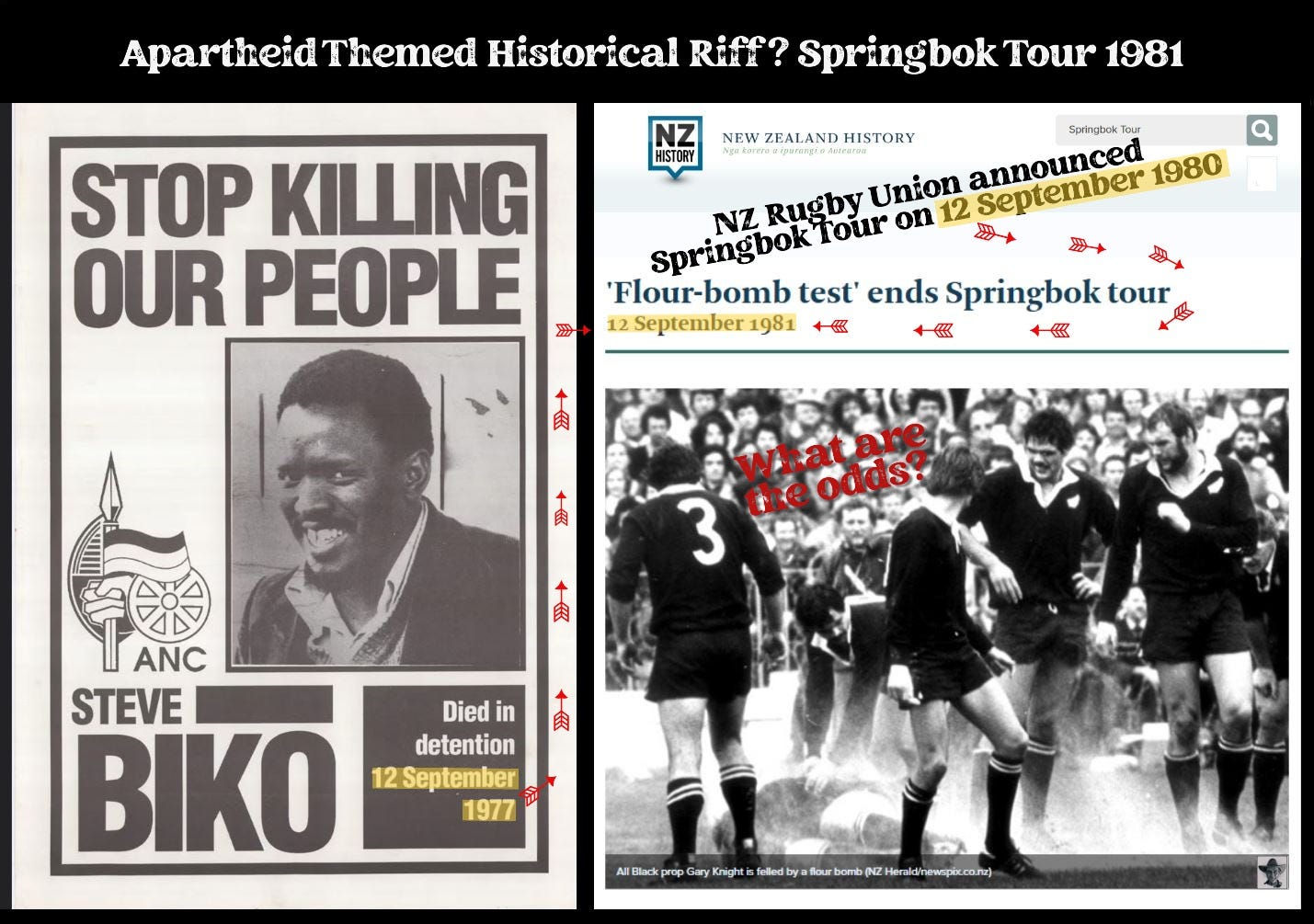
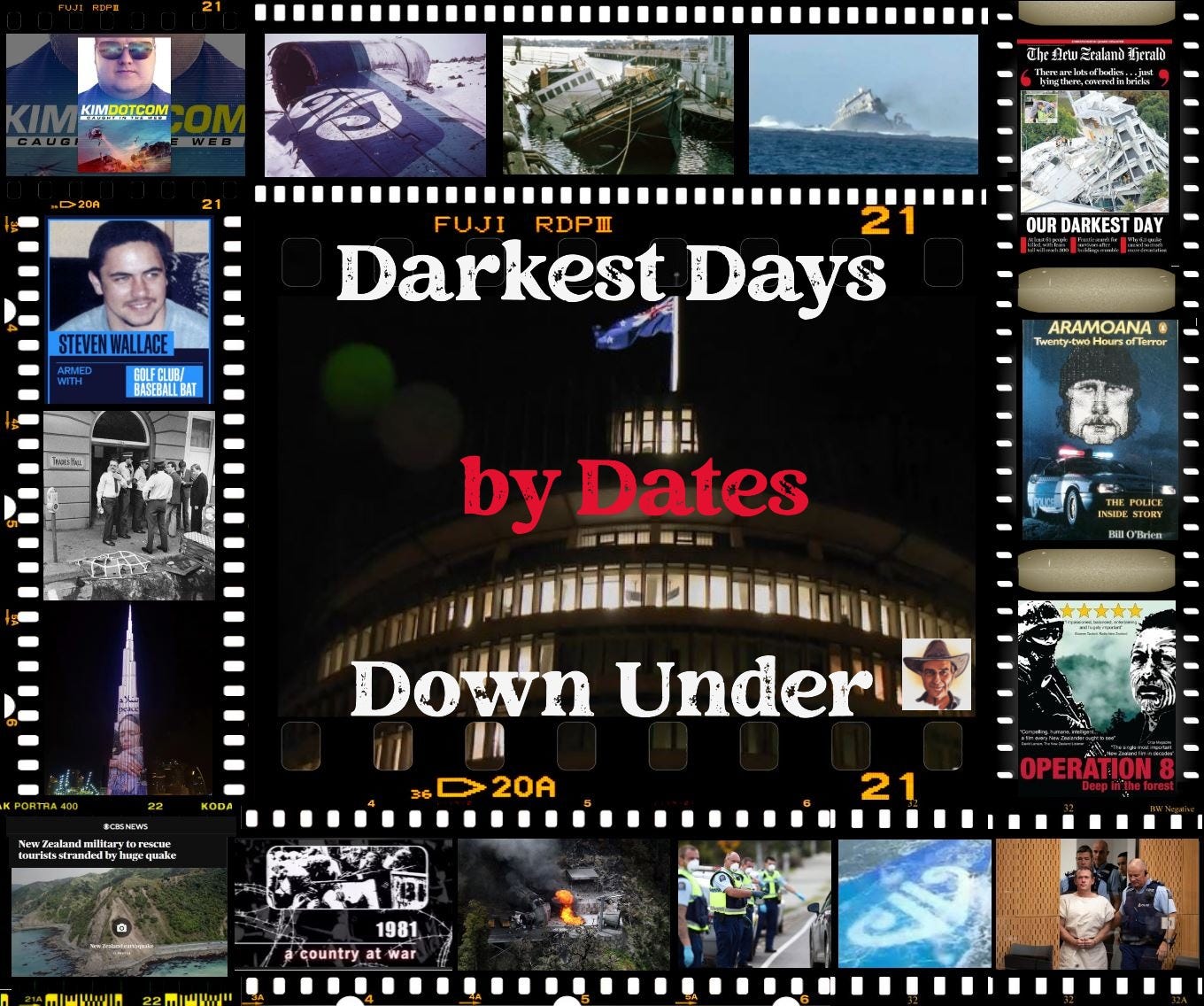



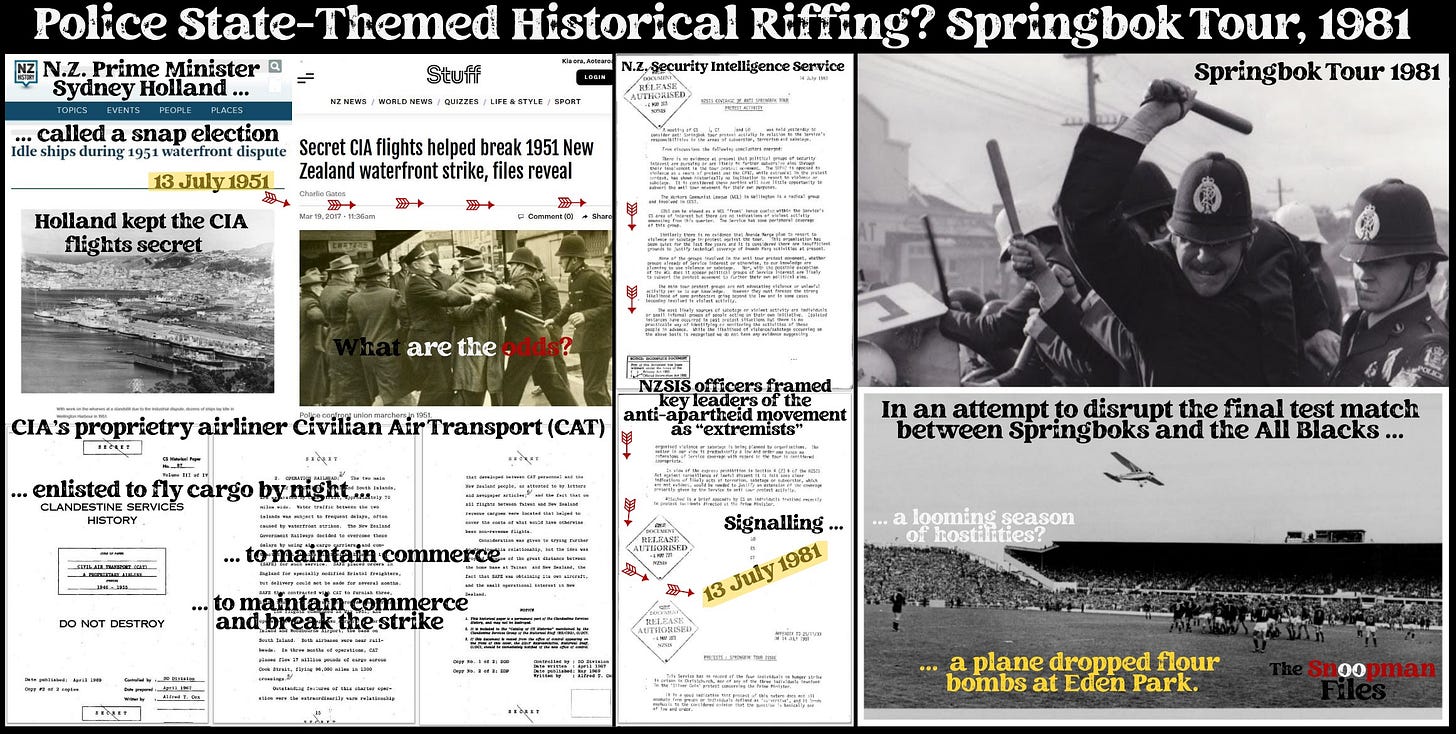
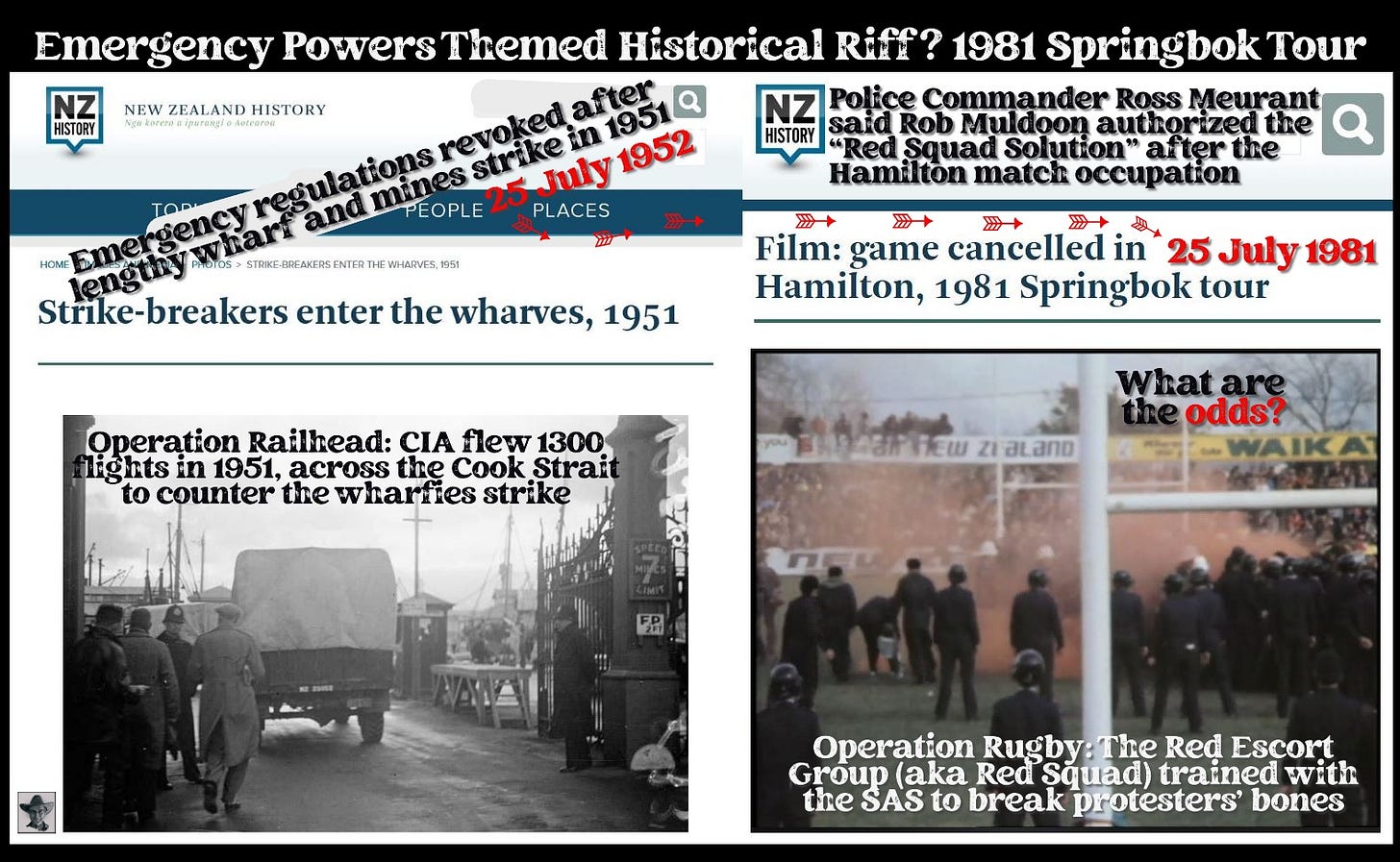
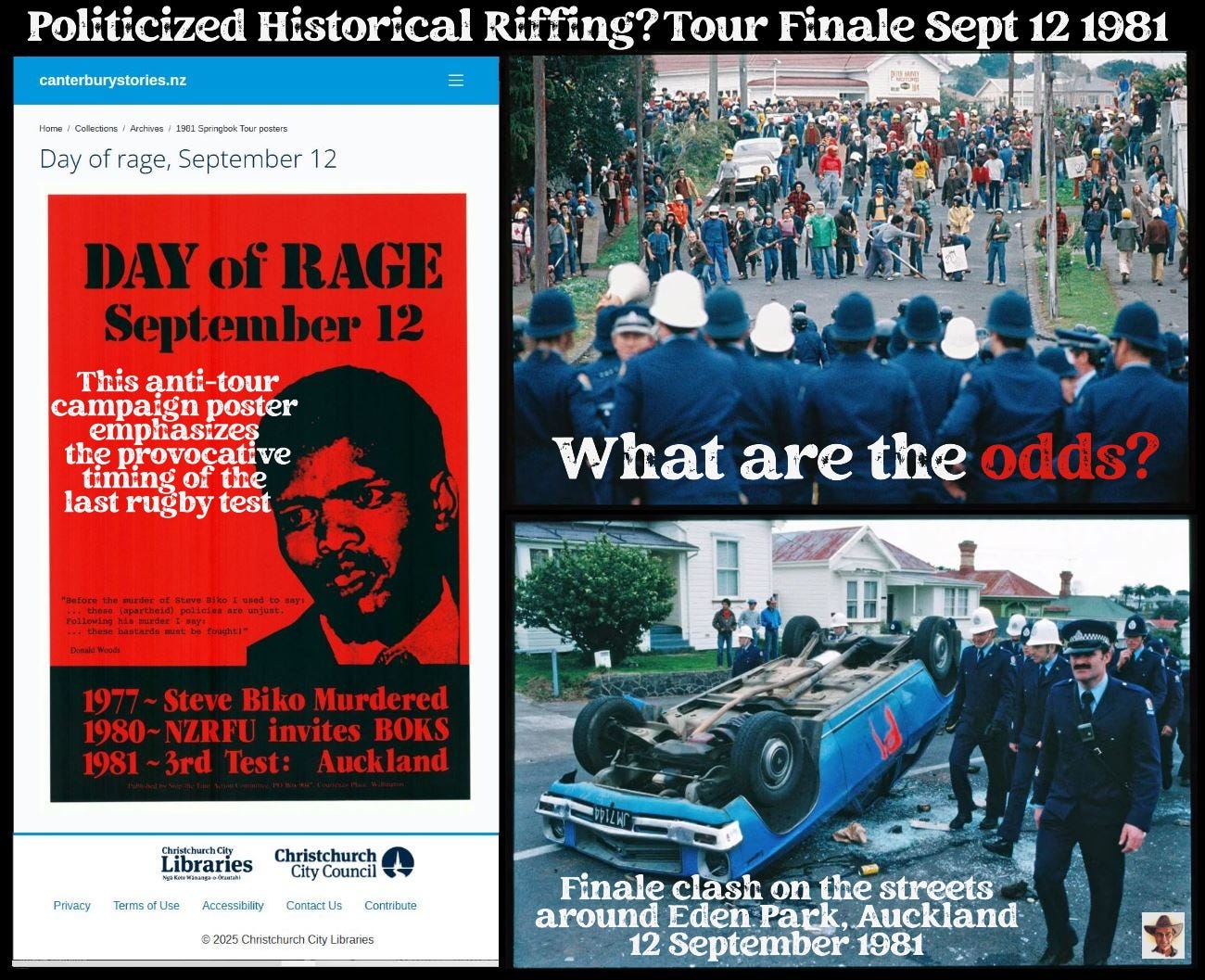
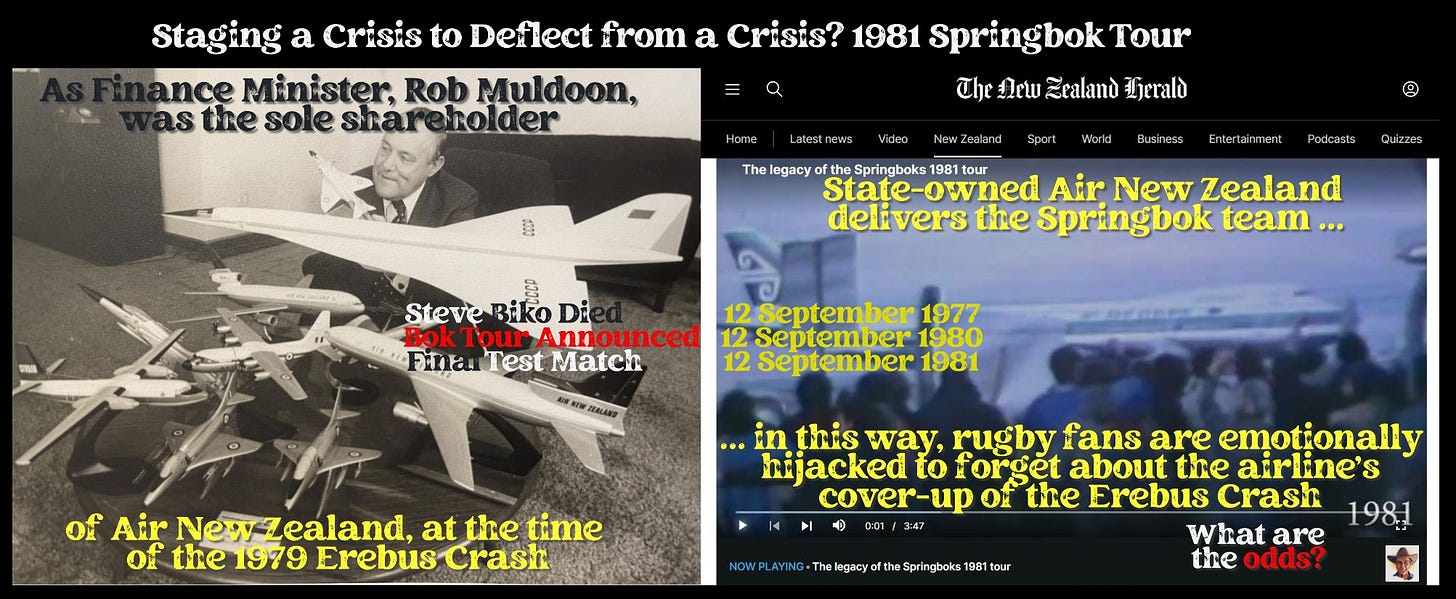


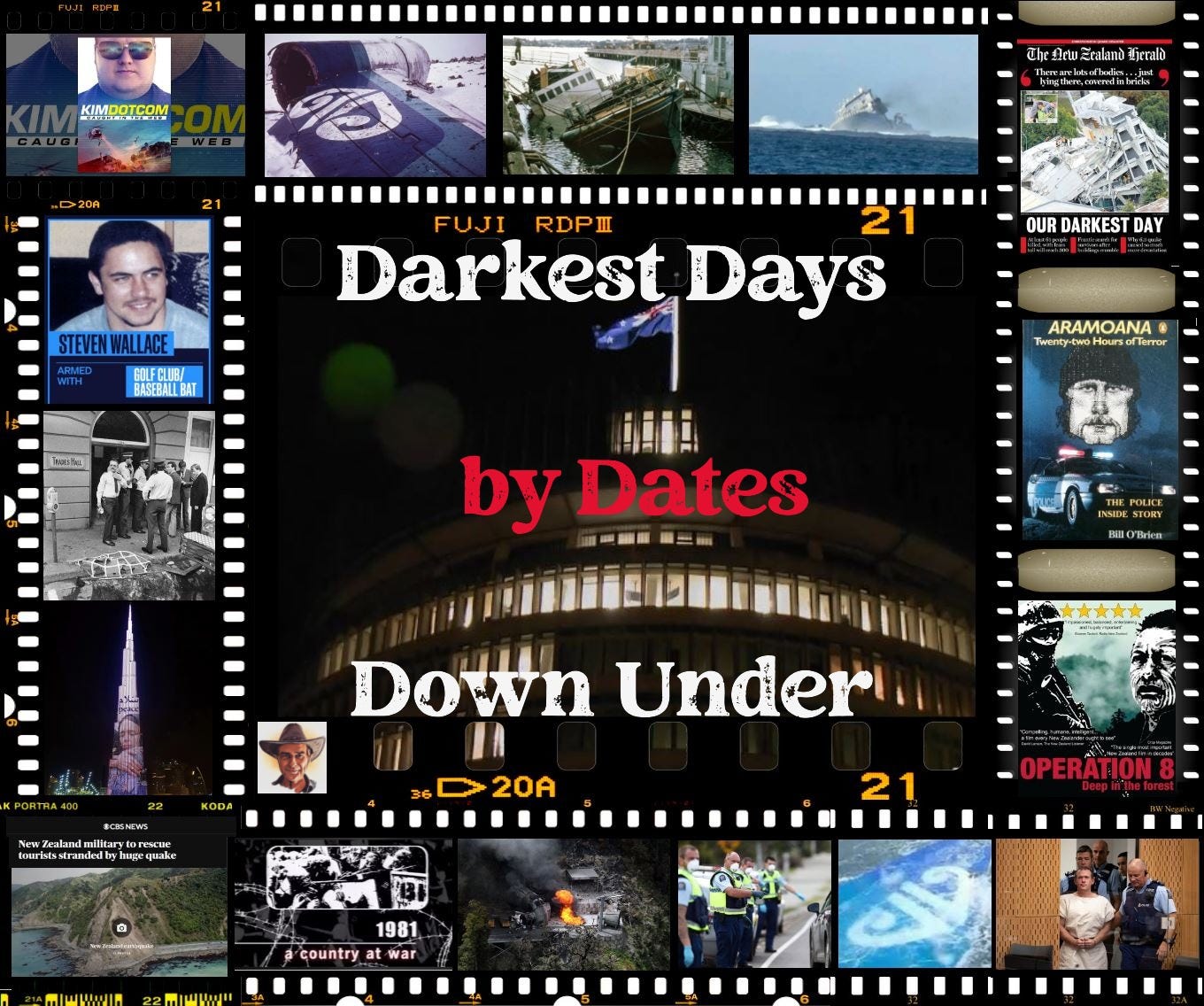
"‘Aussie’ Malcolm" etc. - seems a standard controlling mechanism of politicians - and probably others. Here and internationally.
Regarding apartheid, we were brainwashed (this will not be a popular view in NZ even today). Which is not to say many dreadful events weren't conducted; all successful psy ops need them. Apartheid was not what we were taught (nor was SA's early history), and was part of the psy op used to implement the communist agenda, both in South Africa and here in NZ (and other countries). The indoctrination we had in NZ from the 1950s which intensified in the 1970s & 1980s was successful though.
I met one of the Red Squad police c2013 'in his cups' - retired and on holiday in Geraldine. He told me the Hamilton pitch invasion was intentionally allowed by the police and was used as an excuse to expand the police budget and facilitate the purchase of riot equipment. I looked and this is what in fact did happen. Met John Minto the following year, then teaching in Christchurch (Hornby High from memory but don't quote me on that). Asked him and he got quite angry - an interesting reaction I thought.
Though not about 1981, it's part of the bigger story. I've wanted to read it for a while.
SINNERS AT THE STADIUM by Robert Fenton 1974 1st edition
"A conspiracy in Rugby. This book is so named, by the author, because of his conviction that Rodesia and South Africa were undeserving of the international boycotts in the 1970s and that these were engineered by interest that had no genuine concern for the welfare of black Africans."
https://www.trademe.co.nz/a/marketplace/books/rare-collectable/nz-published/sport/listing/5293666109